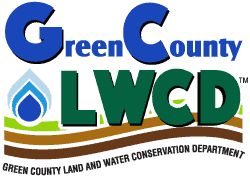
State Programs
Below are State Programs, these are additional to County Programs and Federal Level Programs.
Land and Water Resource Management
Green County receives money for the installation of conservation practices through this program from the Wisconsin Department of Agriculture, Trade, and Consumer Protection. The majority of the practices installed are well abandonment, grassed waterways, stream crossings, streambank improvement, roof runoff, and animal trails. The payment rate for these practices is up to 70% of the cost of the project. We also received money from DATCP for the use of writing nutrient management plans. The payment rate for writing of these plans are up to $40/acre.
Wildlife Damage Abatement
This program is funded by the DNR’s $12 bonus deer permit system, as well as, $2 from every hunting license sold, and is administered by USDA-WS (Wildlife Services). Landowners are able to file for crop damages from deer, turkey, geese, and bear. Fencing and/or pyrotechnics are available through this program to keep the identified species away from crops. If that does not work, hunting of the species may be recommended. Click here for more information.
Conservation Reserve Enhancement
This program has a $200 million budget of federal money and $40 million of state money. This program is designed to improve water quality and wildlife habitat. Riparian buffers and filter strips are the two main practices installed. Targeted areas are lands within 150 feet on either side of streams. For every $1 of state money, the federal government pays out $5. Department staff stake out the buffers and filter strips, GPS them if necessary, write the fifteen year or perpetual contract with the landowner, and do status reviews on the fields after the practice is implemented.
Farmland Preservation/ Agriculture Enterprise Areas
This program is administered by Green County for DATCP. Landowners collect income tax credits for agreeing not to develop their land, to limit soil erosion, meet manure handling standards, and to develop a nutrient management plan. The Working Lands Initiative replaced the Farmland Preservation Program on July 1, 2009. Landowners who have an existing contract will continue to get tax credits until the contract’s expiration date. If one would wish to participate in this program, landowners will need to be in an Ag Enterprise Area or the township to be exclusive ag zoned, To create an Ag Enterprise Area landowners would need to submit an application to DATCP. This application needs to be from at least five contiguous landowners with control of at least 1000 acres. Once the Ag Enterprise Area is approved, the individual landowners could enter into a 15 year contract and receive a $5/acre tax credit each year.
Drainage Districts
The Land and Water Conservation Department has been working extensively with the Green County Drainage Board. The Drainage Board oversees four districts within the county: District #1 (Juda Branch) developed in 1914, District #2 (Little Sugar River) developed in 1951, Broughton District (Norwegian Creek) developed in 1914, and the Decatur District (Sylvester Creek) developed in 1914. The purpose of creating these districts was to straighten the streams to improve drainage, improve agricultural crop land, and to disperse water as quickly as possible. Currently the Drainage Board is working to have each landowner clear and maintain trees that are on or in the streambank corridor. By rule there is to be a 20 foot wide grass buffer along the top of the streambank, with no trees growing. This is for access to the drainage district if work needs to be done.
Nutrient Management Planning
For ten years our department has educated landowners on the importance of nutrient management planning. Classes are held to inform farmers of nitrogen, phosphorus, and potassium management, soil pH, soil amendments, and lime grades. Sessions are held teaching farmers how to write their own plans with the SNAP PLUS program. We welcome all landowners interested in this program to contact us. We also have “alumni” of previous classes that come back in to update their plan annually.
Producer-led Watersheds
Green County LWCD and the Farmers of the Sugar River will work collaboratively to improve soil and water quality within the Middle and Lower Sugar River watershed of Green County. The watershed’s resource concerns involve impaired creeks due to excess phosphorus and sediment loading. The primary objectives of grant implementation are to improve water quality and soil structure through the implementation of conservation practices and by providing outreach and education to farmers. Other goals of grant implementation are to increase awareness of conservation benefits, improve farm productivity and reduce phosphorus and other nutrient runoff from farm fields. The Green County LWCD’s role is to provide nutrient management training and planning assistance to farmers as well as provide information to farmers on available DATCP programs such as conservation engineering and nutrient management training. Farmers of the Sugar River will lead the efforts of the project by reaching out to farmers, providing incentive payments to try innovative conservation practices and involve other partners to leverage efforts.
The group will:
1. Set meeting dates, times, places and agendas.
2. Provide direction and input in topics for seminars and field days.
3. Secure sponsors and donations for operational costs, seminars and field days.
4. Demonstrate conservation practices on their farm for others to learn from.
